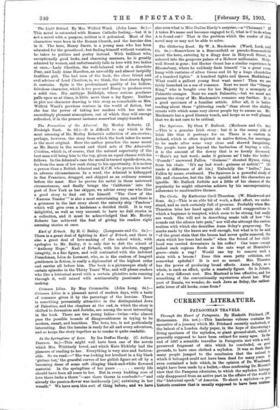C URRENT LITERATURE.
PATAGONIAN TRAVELS.
Through the Heart of Patagonia. By Hesketh Prichard. (W. Heinemann. 21s. net.)—This handsome volume contains the narrative of a journey which Mr. Prichard recently undertook, at the behest of a London daily paper, in the hope of discovering* living specimen of the mylodon, or giant ground-sloth, which is generally supposed to have been extinct for many ages. In the end of 1897 a scientific traveller in Patagonia met with a well- preserved fragment of skin which he concluded, on good grounds, to have once clothed a mylodon. It was so fresh that many people jumped to the conclusion that the animal to which it belonged could not have been dead for many years. It even contained a hole which, in the opinion of Dr. Woodward might have been made by a bullet,—thus confirming Dr. Moreno's view that the Pampean edentates, to which the mylodon belong*, only disappeared from an active part in the affairs of the world in the "historical epoch" of America. To shoot a mylodon--a Pre- historic creature that is• usually supposed -to have been content- renry with the mammoth or the ichthyosaurns, in the vague collocation of biological eras that is due to the ordinary mind— must be a most fascinating prospect to the sportsman of to-day ; and one can imagine the enthusiasm with which Mr. Prichard accepted the offer of Mr. Pearson to organise an expedition to track down the mylodon in its forest fastnesses. Unfortunately the mylodon—if it really exists—refused to appear. Mr. Prichard did not succeed in getting very far away from ground that has aheady been covered by sportsmen or explorers, and, as he justly says, it would be the task of a lifetime really to examine the hundreds of square miles of the Andean forest. He has, how- ever, convinced himself, as far as it is possible to sift the accounts of natives and the probabilities of the case, that the mylodon does not survive in these forests, where he found a singular absence of animal life. It is just conceivable, no doubt, that this may be explained by the fact that the mylodon is not an agreeable neighbour! Mr. Prichard saw a great deal that was interest- ing, and describes it with considerable freshness • of style. His work is disfigured by an occasional slovenliness, as in the passage that meets one's shocked eyes on his fifth page :—" But now the great words of one whose eyes never rested on Andean loneliness marvellously describes it: A land where no man comes nor bath come Since the making of the world, But ever the wind shrills."'
The false concord may be due to the printer, but he can hardly be responsible for the horrid hash of one of Tennyson's finest similes. Mr. Prichard's book is very entertaining, and draws a lifelike picture of the desolate and little-known country with which it deals. It is illustrated with particular richness, though there is surely an excess of fancy in such a picture as the frontis- piece.











































 Previous page
Previous page